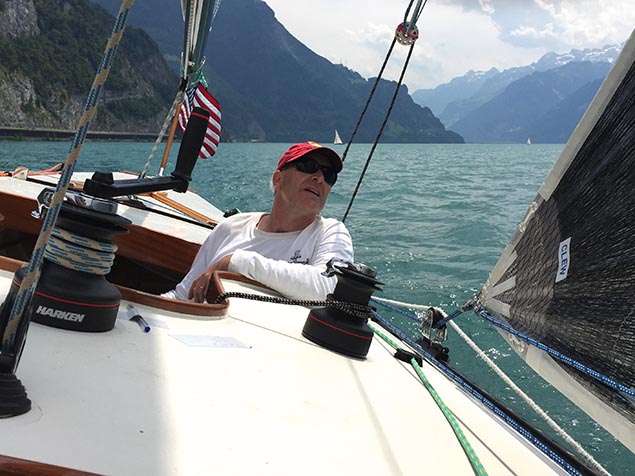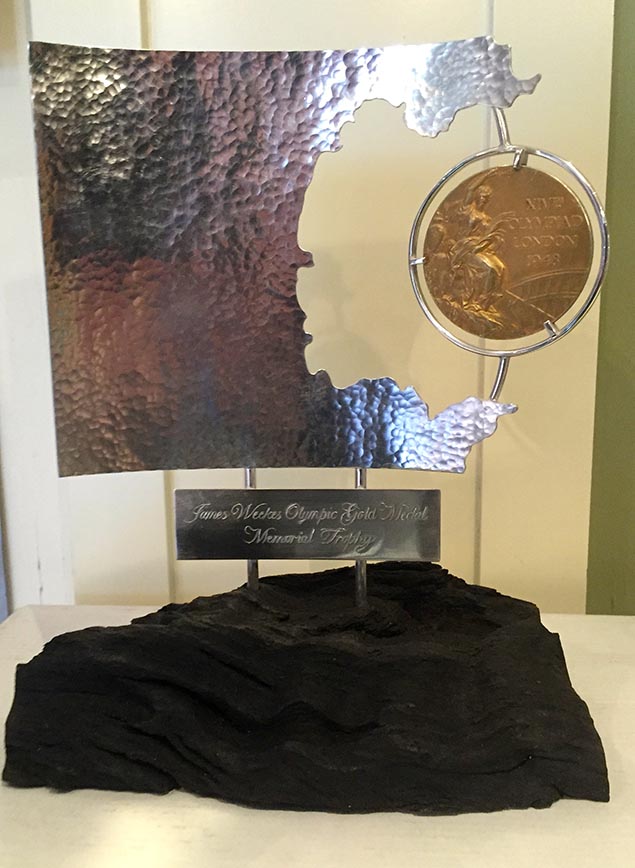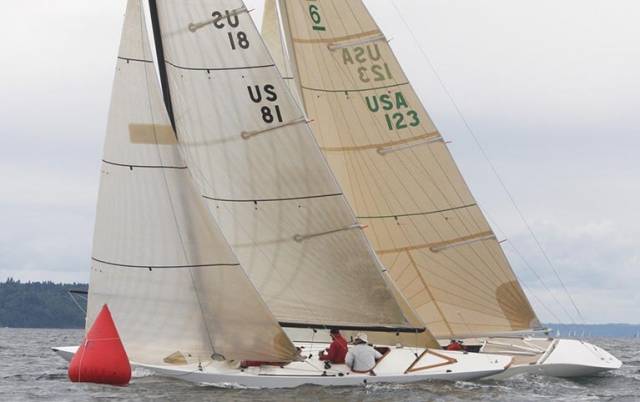These days Dermot O’Flynn, Director of Training in the Royal College of Surgeons in Ireland, does much of his sailing in a classic Water Wag dinghy in Dun Laoghaire and Dublin Bay. But he is a man of wide-ranging nautical experiences and interests, and he has a gem of a story to share with us here:
In life you get some opportunities to do the right thing, and for me this was one of them. In January 2014 my father Dermot O’Flynn, past President of the Royal College of Surgeons in Ireland, died suddenly at the wonderful age of 94. A father, a great surgeon, and a yachtsman who enjoyed any opportunity to be out and about near or on the sea, he left me many happy memories. And he also left me an Olympic Gold Sailing Medal from the 1948 London Olympic Games (understandably known as the Austerity Olympics) which was won by Jim Weekes, who had crewed on the winning American 6 Metre Llanoria.
She was designed by Sparkman & Stephens, and owned by Herman Whiton, who was a member of Seawanhaka Yacht Club on Long Island, New York. On the crew registration for the 1948 Olympics, Jim was listed as James Weekes and the rest of the crew from Seawanhaka Yacht Club were Herman Whiton, Alfred Loomis (who was one of the leading sailing journalists of his day), Michael Mooney & James Smith.
 The veteran but beautifully restored Llanoria, European 6 Metre Classic Champion 2016
The veteran but beautifully restored Llanoria, European 6 Metre Classic Champion 2016
The 6 Metres were the largest and most prestigious of the yachts competing in the 1948 London Olympics, which also included Dragons, Swallows, Stars and the 12ft Firefly dinghy. The famous Danish sailor Paul Elvstrom won his first Gold Medal that year sailing a Firefly dinghy, so Jim and the crew were in good company.
My father was gifted the Medal in 1981 by James Weekes’ wife Kay, who had a been a long term patient and friend of my father. In the accompanying letter she wrote:
“This token comes with my deep affection, no other man deserves it better other than the one who won it, there are no sailors in my family, hand it down to one of yours when the time comes”
My father made the decision to hand down the medal to me probably because I survived the Fastnet Race in 1979 in a 30ft racing yacht, sailed across the Atlantic in 35-foot Camper & Nicholson sloop in 1981, managed a second overall in The Middle Sea Race, and loved sailing all types of boats whether they be dinghies, IRC racing machines, or classic cruising yachts. Yet after putting the medal under lock and key for a while, I came to the decision that the medal did not belong to me or my family, but should be returned to Seawanhaka YC, and so my journey started. Very quickly I discovered that there was only one living relative, named Townsend Weekes, who was also – surprise surprise….- a member of Seawanhaka YC, and he was delighted to hear the medal would be coming home.
 Dermot O’Flynn helming Llanoria on Lake Lucerne, July 2016
Dermot O’Flynn helming Llanoria on Lake Lucerne, July 2016
Townsend informed me that Jim was originally from Oyster Bay, Long Island, New York. He had three siblings, and the family have a long history with Oyster Bay, dating back to 1653 when Francis Weekes settled there. Jim’s grandfather was one of the earliest members of Seawanhaka Yacht Club, and both his brother Arthur and brother in-law Porter were Commodores of this yacht club.
Jimmy - as the family called him - was a terrific athlete who loved sailing and was the best rifle shot of his three brothers. Like his brothers, he had a distinguished career in the American Navy in World War 2, becoming an Executive Officer on a battle cruiser in the Pacific.
Nobody can remember how Jimmy got selected to sail on Llanoria for the Olympics in 1948 but obviously Herman Whiton liked the ‘cut of his jib’, and the Gold Medal sealed the success of their mutual respect.
James Weekes married Kay in 1962, and they moved to Dublin as they wished to live in Ireland, but sadly Jim died suddenly in 1977 at the age of 65. Kay and James had no family, however Kay had family from her first marriage, and they and other Weekes relatives in America had always wondered what happened to the gold medal, so they were intrigued – to say the least - to hear where it had ended up.
Having discovered the background to Jim Weekes, naturally my attention was drawn to the great Llanoria US 83, and what might have happened to her. My journey started by accident when I was delivering an Alden 54 called Tara from St Petersburg to Stockholm via the Finish Archipelago. We happened to spend two wonderful nights on the marina of Helsinki Yacht Club and the club has a half model of Llanoria, plus a photo of her winning the Seawanhaka Cup, for Llanoria had also won the 6 Metre Class in the 1952 Olympics in Helsinki – she is the only yacht to have won two Olympic Gold Medals.
My next port of call was the famous yacht designers Sparkman & Stephens in New York. They very kindly went through their records and found a line drawing of the yacht designed by Olin Stephens which they sent to me, however at that time they had no record of Llanoria’s present location.
But I kept digging for more information, and finally got in touch with Matt Cockburn, secretary of the Puget Sound 6 Metre Association in America’s Pacific Northwest, who gave me the great good news that Llanoria had been totally refurbished by her current owner Peter Hofmann, whose family had purchased her in 1980, and that she had just won the 6 Metre 2015 World Championships (Classic Division) at La Trinite Sur Mer on France’s Biscay coast, helmed by Eric Jespersen.
 Reception at the Seawanhaka Yacht Club on Sunday October 2nd to hand over the James Weekes Memorial Trophy
Reception at the Seawanhaka Yacht Club on Sunday October 2nd to hand over the James Weekes Memorial Trophy
I then contacted Peter Hofmann who was fascinated by the story of the Medal, and he kindly agreed to me joining him and the crew of Llanoria for a sail as they prepared for the 6 Metre European Championships on Lake Lucerne in July 2016. What a joy it was to sail with a crew who knew their yacht so well, and to watch them tune the rig, adjust the sheets, move the mast and create the perfect sail shape for 6 Metre sailing in 8-10 knots of breeze.
Now it was time to move on to the next stage of the Gold Medal’s journey home. In memory of James Weekes I agreed with the Seawanhaka Yacht Club Commodore, Vice Commodore and Committee, through a Deed of Gift, to present the Medal to the Club as ‘The James Weekes Olympic Gold Memorial Trophy’
The trophy represents the coast line of Torbay on England’s south coast, venue of the 1948 Sailing Olympiad, in Irish Silver, with the Gold Medal suspended in the centre of the 1948’s 6 Metre racing area. It is placed on a piece of Irish Bog Oak which is more than 800 years old, chosen for the very personal reason that on the day my father died, his parish priest said to me on hearing the sad news: “Dermot, a great oak has fallen”
At the beginning of October, it gave me and my family great pleasure to present this Memorial Trophy to Seawanhaka Yacht Club, and l look forward over my lifetime to hearing about the sailors who win this trophy, and their successes both on and off the race course.
 The James Weekes Olympic Gold Medal Memorial Trophy honours many cherished memories 68 years down the line since the Torbay Olympics.
The James Weekes Olympic Gold Medal Memorial Trophy honours many cherished memories 68 years down the line since the Torbay Olympics.






























































